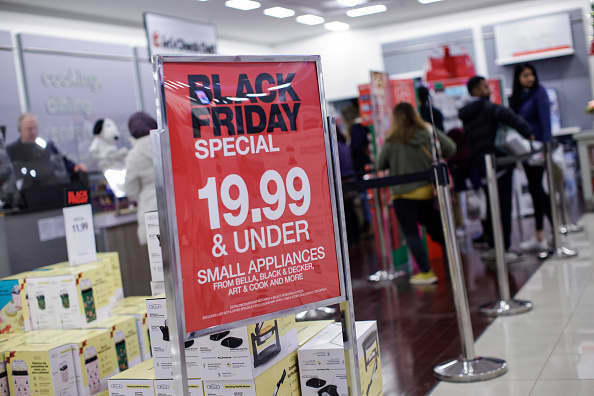Products You May Like
A record number of holiday shoppers – 196.7 million – flocked back to stores and hunted for deals from Thanksgiving Day to Cyber Monday, according to a survey by the National Retail Federation, which tracks the figure for in-person and online shopping.
The trade group did not estimate spending over the weekend, but said Tuesday that sales for the overall holiday shopping season are on track to meet its forecast. It anticipates that holiday sales will rise by 6% to 8% from last year to between $942.6 billion and $960.4 billion. Some of that increase will come from nearly four-decade high inflation.
related investing news
The National Retail Federation defines the holiday season as November 1 through December 31. The sales forecast excludes spending at automobile dealers, gasoline stations and restaurants.
Shoppers spent an average of about $325 on holiday-related purchases over the weekend. That’s higher than last year’s average of $301.
NRF CEO Matt Shay said the weekend’s biggest takeaways are that Americans are eager to shop in-person again and that they’re hungry for big bargains. More than 122.7 million people visited brick-and-mortar stores over the weekend, a jump of 17% from 2021.
As inflation hits Americans’ wallets, he said, promotions have become a important motivator.
“Consumers are out shopping, but they’re out shopping when they see deals and when they get the promotions that meet what it is they’re looking for, and so you can get them engaged, but you’ve got to deliver value and price,” he said on a call with reporters.
Retailers have nevertheless been cautious about their holiday outlooks, particularly as families feel the pinch of inflation. Walmart has spoken about customers skipping over discretionary items and trading down to cheaper proteins like hot dogs and peanut butter. Target cut its forecast for the holiday quarter. And Best Buy said customers have had a higher interest in shopping during sales events.
So far, though, figures from Adobe Analytics showed that online spending hit record highs on key days during the holiday shopping weekend. Black Friday sales rose 2.3% to hit $9.12 billion and Cyber Monday sales rose 5.8% to $11.3 billion, according to the company, which tracks sales on retailers’ websites.
On average, consumers said in the NRF survey that they are about halfway done with holiday shopping. That means retailers can expect more purchases in the weeks ahead, Shay said.
NRF said Tuesday that its tally of shoppers over the holiday weekend topped last year’s turnout of 179 million during the same period last year. The group, which began tracking the figure in 2017, had forecast a turnout of 166.3 million for this year.
A bigger turnout and record spending this holiday season could be a result of a variety of factors. It could indicate that consumers are willing to buy − but only if items are on deep discount. It could also signal a return to the pre-pandemic timetable of holiday shopping, with people concentrating their gift-buying around Black Friday and in the final sprint before Christmas Day.
Or it could portend a more challenging 2023. If Americans are funding shopping spree by slashing savings rates and tallying up big balances on credit cards or through ‘Buy Now Pay Later,’ that could leave them with less to spend in the months ahead.
The National Retail Federation, a major trade group, has taken a bullish stance on consumer spending — saying a strong job market has encouraged Americans to keep spending.
Shay also shook off concerns about a recession on Tuesday, but acknowledged another risk for retailers: the threat of a railway strike. While retailers may have most of their holiday merchandise, he said a work stoppage could be a blow to consumer confidence.
“We think that the holiday season would be the worst possible time,” he said.
−CNBC’s Annie Palmer contributed to this report.


